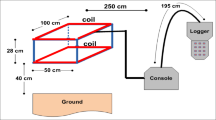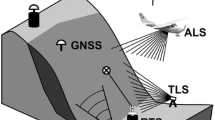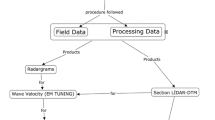Abstract
Modern subsurface prospecting makes use of advanced technologies: coring, geophysical methods, and remote sensing. In the framework of this exciting progress, we have developed two integrated instruments for archaeological investigations. GEOSCOPE consists of a coring machine and a probe: the coring machine bores the soil while recording drilling parameters, the probe performs visual inspections and data acquisitions in the hole. GEOLIDAR is a laser range-finder conceived for the volumetric characterization of buried cavities by means of a motor-driven three-dimensional scan. The data are recorded and displayed to the archaeologist by a user-friendly computer interface. This paper describes the two systems, outlines the rationale that guided their conception, discusses the measurement accuracies and reports the first results.
Similar content being viewed by others
References
Scollar, I., Tabbagh, A., Hesse A., and Herzog, I. 1991, Archaeological Prospecting and Remote Sensing, Book News, Portland, OR.
Cucarzi, M., 1992, The integrated geoarchaeological approach within the territory: The case of the microregion. First results and further proposals, in Bokonyi, S., ed., Cultural landscape changes in southeast, vol. 1: Archaeolingua, Budapest, Hungary, p. 13–40.
Contratto di Ricerca 179201–1325/458, Ministero dell'Università e della Ricerca Scientifica e Tecnologica, Roma, Italy, 1996.
Bosch, T., and Lescure, M., eds., 1995, Selected papers on laser distance measurements: SPIE, Bellingham, WA.
Pedrotti, F.L., and Pedrotti, L. S., 1993, Introduction to optics: Prentice Hall, Englewood Cliffs, NJ.
American National Standard for the Safe Use of Lasers-ANSI Z-136.1, ANSI, New York, NY, 1993.
Carmer, D. C., and Peterson, L. M., February 1996, Laser radar in robotics: Proceedings of the IEEE, v. 84, p. 299–320.
Jelalian, A. V., 1992, Laser radar systems: Artech House, Norwood, MA.
Mamon, G., Youmans, D. G., Sztankay, Z. G., and Mongan, C. E., 1978, Pulsed GaAs laser terrain profiler. Applied Optics, v. 17, p. 205–221.
Press, W. H., Teukolsky, S. A., Vetterling, W. T., and Flannery, B. P., 1994, Numerical recipes in C: Cambridge University Press, Cambridge, UK.
Author information
Authors and Affiliations
Rights and permissions
About this article
Cite this article
Fiorani, L., Bortone, M., Mattei, S. et al. GEOSCOPE and GEOLIDAR: Integrated Instruments for Underground Archaeological Investigations. Subsurface Sensing Technologies and Applications 1, 305–319 (2000). https://doi.org/10.1023/A:1010195608675
Issue Date:
DOI: https://doi.org/10.1023/A:1010195608675




